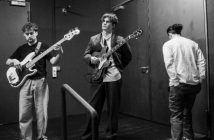Among the films screened as part of Amsterdam Dance Event’s 2015 program, Marc Houle’s Page of Madness inevitably caught my eye. Houle, a Canadian techno producer had not only composed a brand new soundtrack to accompany the avant-garde Japanese silent film, A Page of Madness, but would also be performing it live.
The monochrome palette of early silent film lends the ideal aesthetic to the often dark and brooding sounds of techno, and Houle certainly isn’t the first artists in the genre to exploit this. In the past, similar ventures have achieved various degrees of notoriety; arguably the most well-known being techno pioneer Jeff Mills’ accompaniment to Fritz Lang’ classic Metropolis.
The premiere of Houle’s latest project took place in Melkveg, a cultural hub in Amsterdam’s Leidseplein district. Melkveg is home to a gallery, various stages for live performance, and of course a cinema. Traditionally many silent films were exhibited with live accompaniment, typically from an organ, it therefore seems like a complete inversion upon arrival to see Houle sat left of screen amid a mess of wires, gleaming buttons, and twinkling lights.
Teinosuke Kinugasa originally directed the film in 1926, and for a product of its time, A Page of Madness is an incredibly sophisticated film, fusing recognizably European sensibilities including both Soviet Montage and German Expressionism, whilst also retaining its own distinct aesthetic. The film’s creator Teinosuke Kinugasa was a member of Shinkankaku-ha, which translates roughly as ‘School of New Perceptions’, and it seems only fitting that Kinugasa’s film be revived for a new audience in a way that continues to challenge convention.
A Page of Madness is a bleak film. The continual imagery of prison bars overlayed on top of corridors of cells creates a dense visual mesh of shape and form, mimetic of the protagonist’s growing sense of entrapment. The pace is unrelenting and the intensifying sense of claustrophobia and hopelessness is reflected in Houle’s most pounding movements that accompany the film’s most frenetic cuts.
The narrative follows a man’s attempts to piece his family back together. He takes a job as a janitor in the asylum in which his wife is being treated, in an attempt to break her out. After his first failed attempt, however, a complex string of flashbacks introduce further detail and backstory to the family’s plight. The cyclical nature of events and repetitions of actions amid flashbacks create a hallucinogenic quality to proceedings, where it becomes difficult to trust what is reality and what is imagined.
The film itself does not contain any inter-titles, and consequently the dizzying plot is at times difficult to follow; the provision of a written program to help guide us through the story was a welcome bit of foresight. Whilst the nuances and details of the story demand closer study of the film, at no point is the trajectory of the narrative muddled or confused, because emotion and tone were communicated clearly by Houle’s score.
One of the most remarkable aspects of the performance was Houle’s demeanor as he played: sat upright and poised Houle’s movements as he operated his synths and sequencers were concise and controlled, a stark opposition to the events onscreen. After the performance he even took to the floor with a glass of wine in hand to mingle and speak to his audience.
Despite their arguably disparate contexts of production, Houle’s composition and Kinugasa’s film had a bizarre unity. I think it’s fair to say that we would now consider silent black and white film as a relatively primitive method of production (in comparison to what modern filmmakers can achieve), whilst the live performance of synthesized music sits at the complete opposite end of the spectrum as the most technologically advanced means of musical production. The pairing of such oppositional forms was strangely seamless. The synthesis between moving image and sound was close to perfection. This was largely in part due to Houle’s choice of source material, Kinugasa’s film provided a rich canvas to explore sonically, as the frantic intercut montages of images almost seemed like they had been intended to be scored to a thumping techno beat.



